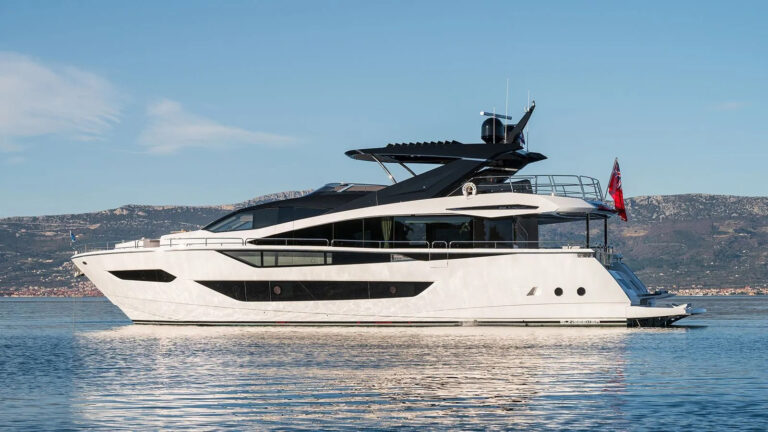One plus one does not normally equal three, unless you add the capability of Loran to GPS/WAAS in a new Secure Navigation System from Si-Tex/Koden. Combining the two systems provides superior position fixing accuracy, enhanced reliability, a high degree of immunity to interference or jamming and a source of accurate heading information both when the vessel is under way and when stationary. The first of what will likely be a number of new GPS/Loran sensors has been developed by Si-Tex, which is also the maker of Koden marine electronics, and will be available for use with chart plotters and autopilots before midyear.
Development of the new GPS/Loran sensors has been spurred by government studies that identified the need for a robust backup for GPS plus the need for enhanced navigation accuracy for both maritime harbor entrance and approach and aviation non-precision landing guidance. Since the GPS and Loran systems operate on vastly different frequencies they provide a highly complementary solution to the need for uninterrupted navigation data. The relative strength of the Loran signal makes it very difficult to jam; it penetrates into areas where wide area sky coverage may otherwise be limited by nearby landmass, structures or foliage. Combining the two navigation systems provides an “always on” solution.
The government study resulted in contracts for the installation of new Loran transmitter equipment, improvements in overall timing accuracy for all transmitters and the development of new Loran receiver technology, including combination GPS/Loran receivers. The first results of this work will become visible to yachtsmen when the first combined receivers reach the marine market late in the spring of this year. Similar aviation units will likely follow not long after.
The new system will provide position information accuracy at least equal to what is achieved with differential GPS and, depending on location, results somewhat superior to what is achieved with a WAAS GPS receiver. Vessel-heading information will be accurate to about 0.5 degrees and will have very little lag, making it a superior source of information for both the vessel’s autopilot and for the radar. In addition, accurate heading information will be available even when the vessel is stationary, unlike a standard GPS receiver that offers indeterminate heading data when the vessel is not moving.
Using the heading information from the GPS/WAAS/Loran receiver will substantially improve autopilot performance when compared with results achieved with the conventional magnetic flux detector. The improvement will be especially evident when operating in a following sea. Heading data is referenced to true north, is unaffected by magnetic dip and acceleration errors and is immune to errors caused by onboard magnetic influences. (At last, it will be easy to compensate the boat’s steering compass without having to run a series of courses.) The relatively high-response speed of the heading information will aid in keeping the radar data image properly aligned with chart information in the overlay mode. Adding a heading source selector switch to existing autopilot installations will allow the user to select between GPS/WAAS/Loran data or revert to the previous magnetic heading sensor.
The first marine units will consist of a dome-shaped antenna similar to a GPS antenna and a small accessory module used to house some of the receiver’s electronics. Later versions will enclose all of the components in the dome. The NMEA data output from the combined GPS/WAAS/Loran receiver will be identical to that from the standard GPS.
The new combined function receiver is totally unlike any you have used before. There is no need to select a Group Repetition Interval (GRI), because the receiver uses all received Loran signals to construct the best possible position fix. In fact, there are no user controls. During development tests, signals from Loran transmitters thousands of miles distant contributed to the accuracy of the position data extracted by the receivers. The new receiver does not require the familiar six-foot Loran “E” field whip antenna. It uses an “H” field antenna that is built into the GPS/WAAS/Loran dome. The substitution of the “H” field antenna greatly improves the Loran receiver’s immunity to the electrical static that is present near lightning storms. The net result is that the combined GPS/WAAS/Loran receiver can be put in operation on a boat without the need for any additional training for the user. It is truly a plug-and-play device.
The position information derived from Loran signals depends on the accuracy of signal timing among the transmitters and local terrain-induced effects on signal propagation. The timing problem that heretofore limited ultimate accuracy has been eliminated in the new system in which all stations are precisely synchronized to UTC (Universal Time, also known as Greenwich Mean Time or GMT). Terrain modeling can reduce or eliminate local effects as was proven during tests in Tampa Bay, Florida, when the distorting effect of the Sunshine Skyway Bridge was identified and compensated for. The Automatic Identification System (AIS) now required on many ships and all SOLAS (Safety Of Life At Sea) vessels requires a precise source of position information, a need easily met by the combination of GPS and Loran data.
The Loran signal format includes provision for a data channel. In the future this capability can be used to disseminate additional navigation information, for example differential corrections for GPS. With minor development the data channel could be used to provide wide-area, and in some cases ocean-wide, navigation and weather-alert information to any vessel equipped with one of the new GPS/Loran receivers.
The price of the new Secure Navigation System receiver has not yet been announced but will likely be about $1,400 at introduction according to company officials. The history of both Loran and GPS indicate that the price will be a fraction of that amount in a relatively short time and eventually may make GPS-only receivers obsolete on larger boats and yachts. Contact: Si-Tex Marine Electronics, (727) 576-5734; www.si-tex.com.









